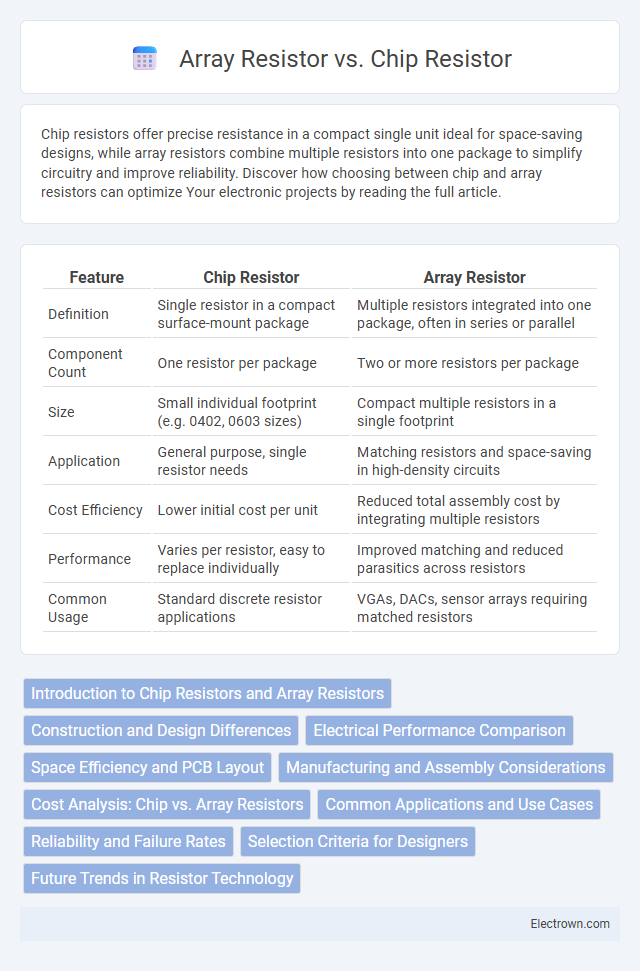Chip resistors offer precise resistance in a compact single unit ideal for space-saving designs, while array resistors combine multiple resistors into one package to simplify circuitry and improve reliability. Discover how choosing between chip and array resistors can optimize Your electronic projects by reading the full article.
Table of Comparison
| Feature | Chip Resistor | Array Resistor |
|---|---|---|
| Definition | Single resistor in a compact surface-mount package | Multiple resistors integrated into one package, often in series or parallel |
| Component Count | One resistor per package | Two or more resistors per package |
| Size | Small individual footprint (e.g. 0402, 0603 sizes) | Compact multiple resistors in a single footprint |
| Application | General purpose, single resistor needs | Matching resistors and space-saving in high-density circuits |
| Cost Efficiency | Lower initial cost per unit | Reduced total assembly cost by integrating multiple resistors |
| Performance | Varies per resistor, easy to replace individually | Improved matching and reduced parasitics across resistors |
| Common Usage | Standard discrete resistor applications | VGAs, DACs, sensor arrays requiring matched resistors |
Introduction to Chip Resistors and Array Resistors
Chip resistors are individual surface-mount components designed for precise resistance in compact electronic circuits, offering reliability and ease of integration. Array resistors consist of multiple resistors embedded in a single package, optimizing space and improving circuit design efficiency by reducing component count. Your choice depends on the specific application requirements, such as space constraints and circuit complexity.
Construction and Design Differences
Chip resistors consist of a single resistor element mounted on a ceramic substrate, encapsulated with protective coatings for durability. Array resistors integrate multiple resistor elements within a single package, sharing a common substrate and terminals to save space and enhance circuit efficiency. Your choice between chip and array resistors depends on design complexity and space constraints in electronic applications.
Electrical Performance Comparison
Chip resistors typically offer precise resistance values with low noise and high reliability, making them ideal for single-point applications requiring stable electrical performance. Array resistors integrate multiple resistors in a single package, providing better matching and thermal tracking between resistors, which enhances performance in applications like DACs and sensor arrays. Electrical performance differences include chip resistors having lower parasitic inductance and capacitance, while resistor arrays improve circuit density and reduce variation between resistors under temperature changes.
Space Efficiency and PCB Layout
Chip resistors offer high space efficiency with their compact individual size, allowing flexible placement across the PCB for optimized signal routing. Array resistors consolidate multiple resistors into one package, significantly reducing component count and saving PCB real estate, especially beneficial for high-density designs. PCB layout benefits from array resistors through simplified routing and reduced solder joints, enhancing assembly reliability and manufacturing speed.
Manufacturing and Assembly Considerations
Chip resistors offer straightforward manufacturing and assembly processes due to their single-component design, making automated placement and soldering efficient on printed circuit boards (PCBs). Array resistors integrate multiple resistor elements into a single package, reducing board space but requiring precise handling to avoid damage during assembly and ensuring consistent solder joint quality across all elements. The choice between chip and array resistors depends on balancing manufacturing speed, assembly complexity, and space-saving requirements for optimal production efficiency.
Cost Analysis: Chip vs. Array Resistors
Chip resistors typically offer lower initial costs and simpler procurement for single-component needs, making them ideal for straightforward circuit designs. Array resistors consolidate multiple resistors into one package, reducing assembly time and PCB space, which can lead to cost savings in mass production runs. Your choice depends on balancing part cost against manufacturing efficiency and overall design complexity.
Common Applications and Use Cases
Chip resistors are ideal for individual circuit components requiring precise resistance values in compact electronic devices, often used in consumer electronics and automotive electronics. Array resistors consolidate multiple resistors into a single package, optimizing space and improving circuit reliability, making them suitable for parallel or series resistor networks found in telecommunications and industrial control systems. Your selection depends on whether discrete or integrated resistor configurations best meet your device's design and performance requirements.
Reliability and Failure Rates
Chip resistors typically offer higher reliability and lower failure rates due to their simpler construction and fewer connection points, minimizing potential failure modes. Array resistors, while space-saving and cost-effective for multiple resistor applications, may have increased risk of failure if one element fails, potentially affecting the entire network's performance. Factors influencing reliability include thermal stress, electrical overstress, and manufacturing quality, with chip resistors generally exhibiting better performance in high-reliability environments.
Selection Criteria for Designers
Chip resistors offer precise resistance values and compact size, making them ideal for high-density circuit boards requiring individual component control. Array resistors simplify PCB layout by integrating multiple resistors in a single package, reducing assembly time and improving matching accuracy in applications like pull-up or pull-down resistor networks. Designers select chip resistors when customization and space optimization are critical, while array resistors are preferred for consistent performance and easier manufacturing in repetitive resistor patterns.
Future Trends in Resistor Technology
Future trends in resistor technology emphasize miniaturization and enhanced performance, with chip resistors advancing in precision and thermal stability for high-frequency applications. Array resistors continue evolving to offer higher integration density and improved matching characteristics, reducing circuit complexity and manufacturing costs. Your electronic designs will benefit from innovations like embedded resistors and novel materials, boosting reliability and supporting next-generation compact devices.
chip resistor vs array resistor Infographic

 electrown.com
electrown.com